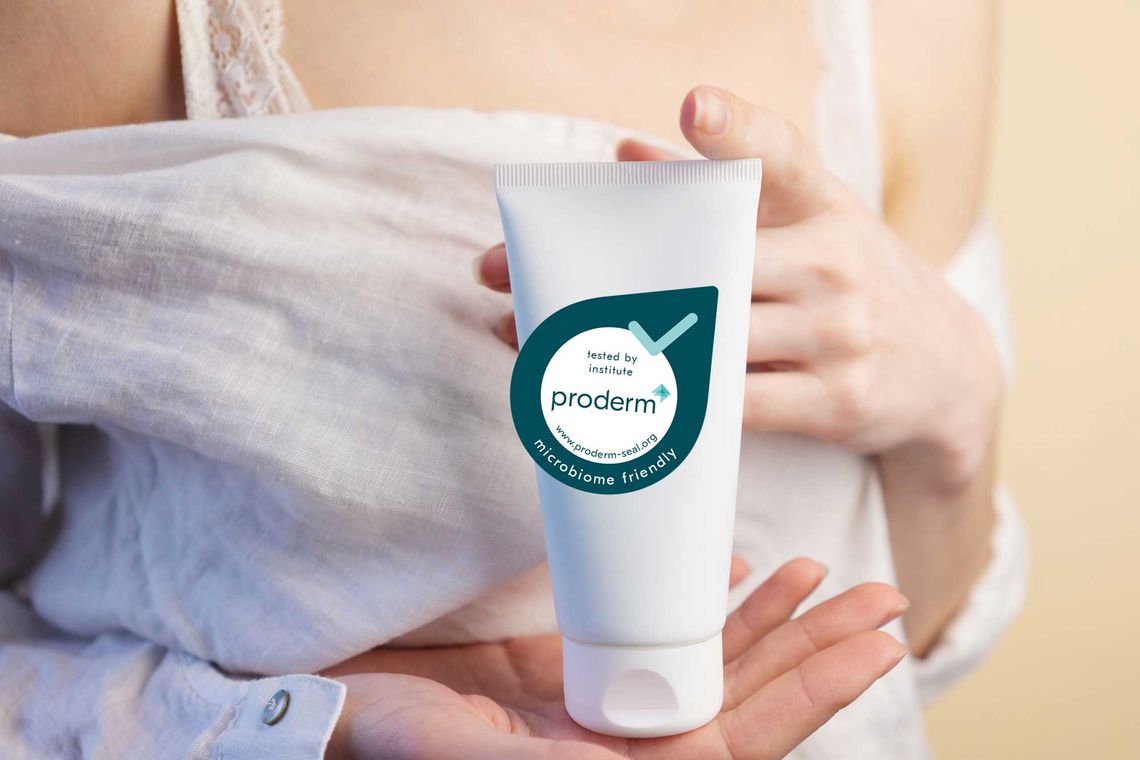Focus on the skin flora
The 'microbiome-friendly' seal from proderm
New methods of gene sequencing have led to a rethinking of the microbial colonization of our skin. Whereas in the past the focus was predominantly on dangerous and disease-causing bacteria, which had to be combated by washing, disinfecting and, if necessary, antibiotics, today the focus is on the care and maintenance of an intact skin microbiome.
Since it has become possible to determine the entire microbiome on an area of skin by simply swabbing it with a cotton swab and then sequencing the genes, our skin flora has been completely re-evaluated by science. It has turned out that the vast majority of bacteria cannot be grown in culture and were therefore simply overlooked in the past. It is now clear that the vast majority of bacteria on the skin are so-called commensals, harmless bacteria that feed on skin lipids and proteins, which are abundantly provided by the constantly renewing horny layer of the skin. A number of bacteria even have a probiotic effect. This means that they make themselves useful on the skin by, for example, displacing pathogenic bacteria.
In view of the new findings, a rethink has also taken place in cosmetic science. Cosmetics should no longer necessarily fight bacteria. Rather, the aim is to keep the skin in good condition, also in relation to the skin's own microbiome. If substances are applied to the skin during cosmetic care, this can also influence the living conditions of the natural skin microbiome. For example, ingredients can act as nutrients to increase certain bacteria, or as inhibitors to impair their growth. It is therefore not unlikely that the regular use of a certain cosmetic product will alter the skin microbiome. This also applies to washing products. Depending on their washing properties, they remove bacteria from the skin, so in principle they can influence which bacteria grow back and in what numbers they do so.
If a cosmetics manufacturer wants to rule out the possibility that its cosmetic product alters or even impairs the skin microbiome, this can be investigated by proderm in a scientific study.
To ensure that such a study meets a high quality standard, proderm has qualified the method and standardized the test design.
The study is carried out on at least 30 test subjects who are selected in such a way that they could be potential users of the cosmetic product under investigation. If, for example, the product is intended for the older skin of women, a corresponding test panel is recruited at proderm. The application is carried out over four weeks according to the application instructions for the product. At the beginning and end of the study, swab solutions are obtained from the treated skin using cotton swabs and buffer solution and the microbiome is analyzed
If the skin microbiome has not changed in a relevant way during the four weeks of application, proderm can award the claim "microbiome friendly". We assume a non-relevant change if the biodiversity (Shannon Index) has not changed significantly. Furthermore, the microbiomes must be genetically very similar at the beginning and at the end of the study and must not differ statistically significantly from each other. This is checked in a principal component analysis. For the quality seal to be awarded, individual bacterial genera must also not have changed significantly in their frequency of occurrence, the skin pH must be unchanged, and the product must also have been excellently tolerated clinically.
Your steps to the microbiome seal:
- Conduct an efficacy study with at least 30 subjects.
- Application: 4 weeks
- Analysis of the microbiome at the beginning and end of the study
- Dermatological evaluation of the skin
- Analysis of pH value and skin barrier
- Agreement on scope of seal use
- Media
- Countries
- Products
- Conclusion of user agreement




